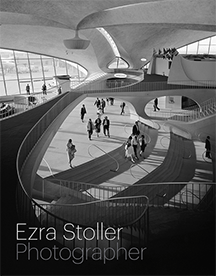By Svetlana Alpers
Those were the days. Or at least that comes to mind looking at Ezra Stoller’s stunning photographs of the TWA terminal at Idlewild airport , as JFK was called when the building opened in 1962. The clear, angling in, black and white photographs were made to serve Eero Saarinen’s distinctive, modernist architecture. The complex spaces, the sinuous curve of walls floors and the wild play of light and shadow appear nearly empty of people. But spaciousness and an invitation to move with grace was in the nature of that space. Those were the days when an airport terminal could be an elevating architectural experience rather than a place for passengers to get through security lines and shop. Now it is no longer suited to function as a terminal. Recent reports have it that a high-end developer hopes to turn the landmarked building into a hotel. Sic transit.
Stoller (1910-2004) studied architecture and design at NYU and then turned to photographing what he knew best. He was a commercial photographer by trade—working for Time Inc.’s magazine Architectural Forum, but also for corporations who commissioned buildings and for the architects who designed them. He started in the 1930s and stopped by the 1990s. His memorable work is devoted to the range and possibilities of mid-century America.
This handsomely printed book presents a selection from the more than 50,000 images Stoller made in three categories: buildings; the workspace; houses and homes. But to put it that way does not match the glamour on view as you turn the pages. Post WWII America was a world of new synthetic materials, of new architectural ideas and of huge optimism. Stoller’s skills let the corporate buildings show themselves to best advantage. Meanwhile, in clean factories and orderly offices neatly dressed men and women work with beautiful appearing materials, and the modest suburban houses designed for average middle-class citizens have great kitchens and ample windows that allow inside and outside to meet. The automobile is a subtle presence, its styling a poignant historical marker.
These photographs avoid social commentary. But the elegance of the corporate headquarters and of the people caught at their work or in their homes makes one wonder about circumstances. How real is all this? That is a question about the world as well as it a question about photography’s relationship to it.
Stoller’s given subject was Modernism. It offered an ideal. The technical care and skill with which Stoller created its image are evident. His choice of cameras, of lenses, of lights is set forth in small print at the end of the book. The photographs he made of buildings by Saarinen, Louis Kahn, Philip Johnson or Skidmore, Owings and Merrill make Modernism real for us. But the perfection of his images is in line with the in-your-face artifice that is right now one characteristic of photography as Art. That is the sense in which this publication of Stoller’s photographs is about today, as well as about the past.
Svetlana Alpers, an artist, critic and renowned art historian, is professor emerita of the history of art at the University of California, Berkeley and a visiting scholar in the Department of Fine Arts at New York University.




